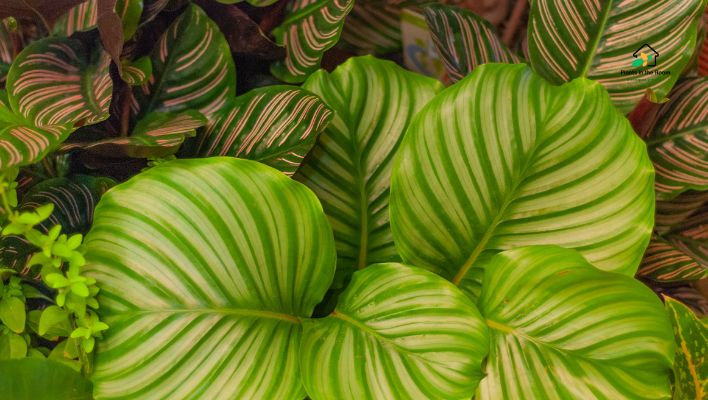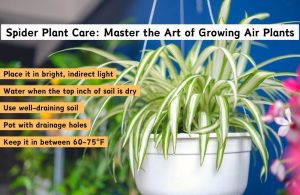This article covers the following areas –
- #1 Provide the Right Amount of Light
- #2 Maintain Proper Humidity Levels
- #3 Water with Care
- #4 Choose the Right Pot and Soil
- #5 Keep an Eye on the Temperature
- #6 Fertilize with Care
- #7 Prune and maintain for optimal growth
- #8 Watch Out for Pests and Diseases
- #9 Propagate Your Calathea
- #10 Understand and Address Common Calathea Issues
- In Conclusion
- Get to Know Your Calathea
When I first brought home my Calathea, I was captivated by its striking foliage and couldn’t wait to watch it thrive in my living space. However, I quickly realized that this tropical plant required some special attention to keep it healthy and vibrant. After a lot of research and experimentation, I’ve learned some crucial tips that have helped me maintain my Calathea in top shape, and I’m excited to share them with you.
For Calathea care, provide medium to bright indirect light, keep soil evenly moist, and maintain high humidity (60-80%). Ensure temperatures between 65-80°F (18-27°C) and fertilize every 4-6 weeks with balanced liquid fertilizer.
Well! I have much more to share in detail. Keep reading this post for a comprehensive guide on how to keep your Calathea thriving, covering everything from specific care requirements to troubleshooting common issues.
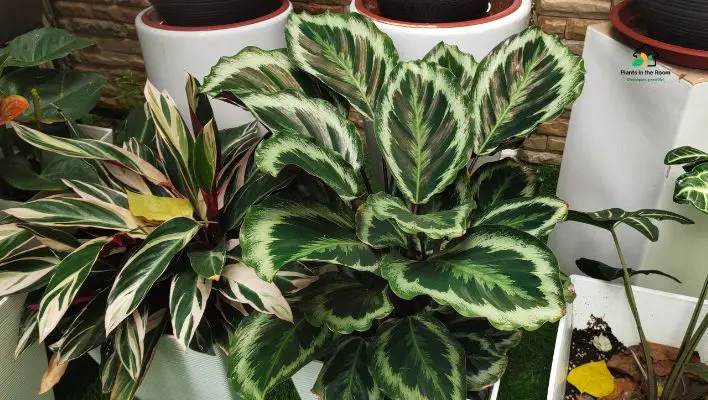
#1 Provide the Right Amount of Light
One of the first things I discovered about my Calathea was that it thrives in indirect sunlight. These plants are native to the rainforest floor, so they’re used to receiving dappled light beneath the canopy.
To mimic these conditions, I placed my Calathea near an east or north-facing window, where it received bright but indirect light. I made sure to avoid direct sunlight, which can scorch the leaves and cause them to lose their vibrancy.
#2 Maintain Proper Humidity Levels
The humidity levels in my home were nowhere near the tropical rainforest conditions that Calatheas are accustomed to. To remedy this, I tried several methods like,
- Placing a pebble tray filled with water under the pot, allowing the water to evaporate and increase the humidity around the plant.
- Regularly misting the leaves with water, ensuring I only used distilled or rainwater to avoid mineral buildup.
- Investing in a humidifier to maintain consistent humidity levels.
These steps have made a significant difference in my Calathea’s health, preventing its leaves from becoming brown and crispy.
#3 Water with Care
Proper watering is crucial for maintaining a healthy and vibrant Calathea. Achieving the right balance between too much and too little water can be challenging, but with attention and practice, you can master this essential aspect of Calathea care.
Assessing Soil Moisture
One key to successful watering is regularly checking the soil moisture. Calatheas prefer their soil to be consistently moist but never waterlogged. To determine when it’s time to water, feel the top inch of the soil with your finger. If it’s dry to the touch, it’s time to water your plant.
Watering Technique
When watering your Calathea, it’s important to use a gentle approach. Slowly add water to the soil, allowing it to absorb the moisture. Continue watering until you see water start to drain from the bottom of the pot.
This ensures that the root system is thoroughly hydrated. To prevent root rot, empty the saucer beneath the pot after watering, making sure your Calathea doesn’t sit in standing water.
Choosing the Right Water
The type of water you use for your Calathea can also impact its health. Tap water often contains minerals, such as chlorine and fluoride, which can be harmful to sensitive plants like Calatheas. To avoid potential issues, consider using distilled water or collected rainwater.
Alternatively, you can leave tap water in an open container for 24 hours to allow some of the chemicals to evaporate before using it to water your plant.
Adapting to Seasonal Changes
It’s worth noting that your Calathea’s watering needs may change with the seasons. During the warmer months, you’ll likely need to water more frequently to maintain the right level of soil moisture. Conversely, in cooler months, you can reduce the frequency of watering as the plant’s growth slows down and it requires less water.
#4 Choose the Right Pot and Soil
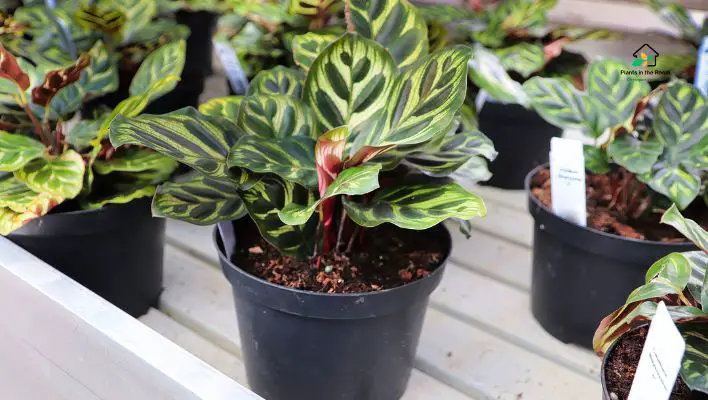
Initially, I underestimated the importance of the right pot and soil for my Calathea. After some research, I repotted it into a well-draining container with drainage holes to prevent waterlogging.
I also used a high-quality potting mix specifically designed for tropical plants, which had the right balance of nutrients and drainage properties.
#5 Keep an Eye on the Temperature
Maintaining the right temperature is vital for Calathea plants, as they are sensitive to fluctuations and extreme conditions. Ensuring that your plant enjoys a stable environment will significantly contribute to its overall health and well-being.
Ideal Temperature Range for Your Calathea
| Temperature Range | Suitability for Calatheas |
|---|---|
| 65°F – 80°F (18°C – 27°C) | Ideal for Calathea growth |
| Below 60°F (15°C) | Too cold, may cause stress and leaf damage |
| Above 85°F (29°C) | Too hot, may cause wilting or stunted growth |
How to Maintain the Ideal Temperature
- Place your Calathea in a room where the temperature remains consistently between 65°F and 80°F (18°C – 27°C).
- Avoid areas with significant temperature fluctuations, such as near exterior doors or poorly insulated windows.
- Cold drafts from windows, doors, or air conditioning vents can stress your plant and cause damage to the leaves. Ensure that your Calathea is not exposed to such drafts, and consider relocating it if necessary.
- If you struggle to maintain a consistent temperature in your home, consider using a heat mat under your Calathea’s pot. This can help provide the plant with a stable, warm base to support its growth.
- Keep the humidity at the optimal level (60-80%); it will create a more comfortable environment for your Calathea to thrive.
#6 Fertilize with Care
Fertilizing your Calathea is an important aspect of its overall care, as it provides the plant with essential nutrients to support healthy growth. However, it’s crucial to fertilize with care to avoid harming your plant.
When it comes to fertilizing your Calathea, using a balanced liquid fertilizer is an excellent choice. The equal ratio of nitrogen, phosphorus, and potassium in a balanced fertilizer ensures that your plant receives the necessary nutrients for foliage, root, and overall growth. It’s important to dilute the fertilizer to half strength, as Calatheas are sensitive to excessive nutrients, which can lead to leaf browning or curling.
During the growing season, which typically spans from spring to summer, fertilize your Calathea approximately once every 4-6 weeks. This frequency provides your plant with a consistent supply of nutrients without overloading it.
Make sure to follow the specific instructions on the fertilizer label, as different products may have varying recommendations. Also, it’s a good idea to water your Calathea before fertilizing to ensure the soil is moist. This practice helps to prevent fertilizer burn, which can occur if concentrated nutrients come into direct contact with your plant’s roots.
In the dormant months, such as fall and winter, it’s best to reduce or even stop fertilizing your Calathea altogether. This is because the plant’s growth slows down during this period, and it requires fewer nutrients.
#7 Prune and maintain for optimal growth
Regular pruning and maintenance are essential for keeping your Calathea in top condition. This not only ensures a visually appealing plant but also promotes its overall health and vitality. Here are some ways to help you maintain your Calathea:
a) Inspect Regularly
Routinely examine your Calathea for yellowing, damaged, or diseased leaves. Look for signs of pests or diseases, as early detection is crucial for effective treatment.
b) Prune Strategically
Use clean, sharp scissors or pruning shears to remove unhealthy leaves. Cut as close to the base of the leaf stem as possible, taking care not to damage nearby leaves or stems. Regularly removing dead or dying leaves helps redirect energy to healthy growth and prevents the spread of diseases or pests.
c) Promote Bushiness
To encourage a fuller, bushier appearance, pinch back the new growth tips of your Calathea. This stimulates the plant to produce more stems and leaves, resulting in a denser, more vibrant plant.
d) Rotate Your Plant
To ensure even growth, rotate your Calathea every couple of weeks. This prevents the plant from becoming lopsided, as it will naturally grow toward the light source.
e) Clean the Leaves
Calathea plants have large, broad leaves that can accumulate dust over time. Gently wipe the leaves with a damp cloth or sponge to remove dust and improve the plant’s ability to photosynthesize. Be cautious not to use any harsh chemicals, as this can damage the delicate leaf surfaces.
f) Repot When Necessary
Calatheas typically need repotting every 1-2 years or when they become root-bound. Gently transfer your plant to a slightly larger pot with fresh, well-draining soil to promote healthy root growth and overall plant vigor.
#8 Watch Out for Pests and Diseases
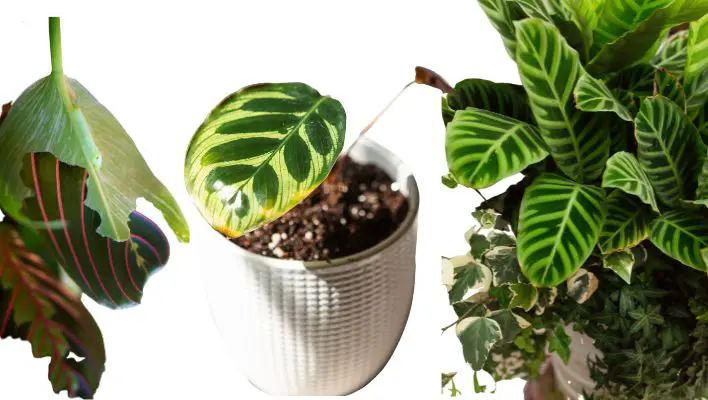
Maintaining your Calathea’s health also means staying vigilant about potential pests and diseases. By staying vigilant and taking prompt action against pests and diseases, you can keep your Calathea healthy and vibrant.
Remember, prevention is key, so maintain proper care practices and monitor your plant regularly for any signs of trouble. Here, I’ll elaborate on some common pests and diseases and how to prevent or treat them.
Spider Mites
These tiny, spider-like pests can cause leaf discoloration and eventually defoliation. They often thrive in dry conditions, so maintaining high humidity can help prevent them. If you notice webbing on the undersides of leaves or fine stippling, treat the infestation by spraying your plant with insecticidal soap or neem oil.
Mealybugs
These small, white, cottony insects can cause leaf yellowing and reduced growth. They are often found in the crevices of leaves and stems. To treat mealybugs, dab them with a cotton swab dipped in rubbing alcohol or apply insecticidal soap or neem oil to the affected areas.
Aphids
These small, pear-shaped insects can cause leaves to curl and stunt growth. They typically cluster on new growth and can be in various colors, including green, black, and white. To combat aphids, spray your plant with insecticidal soap or neem oil, or release beneficial insects like ladybugs or lacewings.
Thrips
Tiny, slender insects can cause silvering or distortion of leaves. They can be difficult to spot due to their small size. To treat thrips, apply insecticidal soap or neem oil, and consider using sticky traps to catch them.
Root Rot
Overwatering or poor drainage can lead to root rot, a fungal disease that causes roots to become mushy and discolored. To prevent root rot, use well-draining soil and avoid overwatering. If you suspect root rot, remove the affected roots, let the plant dry out, and repot in fresh, well-draining soil.
Fungal Infections
Fungi, like powdery mildew and leaf spot, can cause discolored or spotted leaves. To prevent fungal infections, ensure proper air circulation around your plant and avoid splashing water on the leaves. Treat existing infections with a fungicide or by removing affected leaves.
#9 Propagate Your Calathea
One of my favorite aspects of Calathea care is propagation. This allows me to expand my collection or share my love for these plants with friends and family.
To propagate, I carefully divide the plant at the roots during repotting, ensuring each division has a healthy root system and foliage.
I then plant each division in a suitable pot with the appropriate potting mix, following the care tips outlined in this guide.
#10 Understand and Address Common Calathea Issues
Even with the best care, Calatheas can sometimes experience issues. Two common problems I’ve encountered are leaf curling and browning.
Leaf curling is often caused by underwatering, low humidity, or exposure to drafts. To remedy this, I ensure my plant is receiving adequate water, humidity, and protection from temperature fluctuations.
Browning leaves can result from various factors, such as over-fertilization, direct sunlight, or mineral buildup in the soil. I address this by adjusting my care routine accordingly and keeping a close eye on my plant’s environment.
In Conclusion
By following these Tips, I’ve managed to keep my Calathea healthy and vibrant. I love watching it grow and thrive, and I’m confident that if you follow these tips, your Calathea will flourish too. Happy planting!
Get to Know Your Calathea
| Indicator | Calathea (Calathea spp.) |
|---|---|
| Family | Marantaceae |
| Genus | Calathea |
| Common Name | Prayer Plant, Zebra Plant, Peacock Plant, Rattlesnake Plant |
| Origin | Tropical regions of Central and South America |
| Plant Type | Evergreen, Herbaceous |
| Mature Size | 1-3 feet (30-90 cm) in height, 1-2 feet (30-60 cm) in spread |
| Growth Rate | Moderate |
| Light Requirements | Medium to bright, Indirect Light |
| Watering Requirements | Keep soil evenly moist, Do not allow to sit in water |
| Soil Preference | Well-draining, Peat-based mix |
| Temperature Tolerance | 65-80°F (18-27°C) |
| Humidity Tolerance | High Humidity (60-80%) |
| Fertilization | Every 4-6 weeks during the growing season, Balanced liquid fertilizer |
| Propagation | Division, Stem Cuttings |
| Pests | Aphids, Mealybugs, Spider Mites, Thrips |
| Diseases | Bacterial Blight, Fungal Diseases, Root Rot |
| Toxicity | Non-toxic to humans and pets |
| Special Features | Attractive, Colorful Foliage, Air-purifying |
| Popular Uses | Indoor Decoration, Tropical Gardens, Container Gardens |
I hope you found this information helpful for keeping your Calathea healthy and vibrant. I’d love to hear from you! Please feel free to share your thoughts, opinions, or personal tips for Calathea care in the comments section below.
Happy planting!

